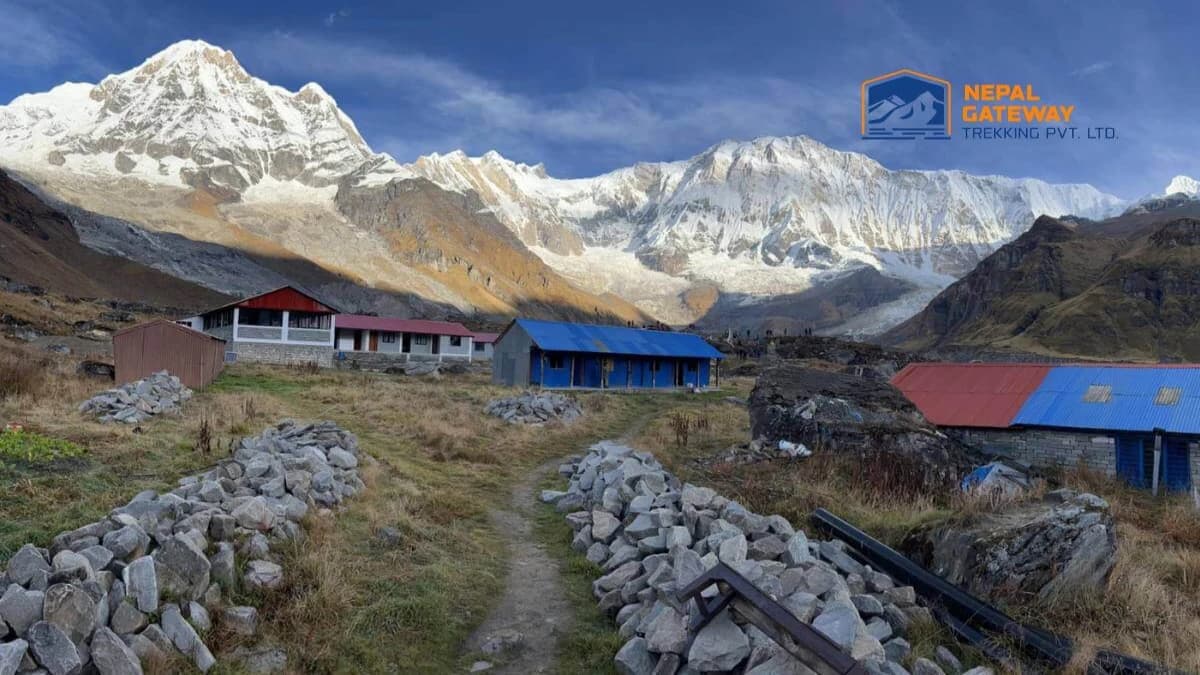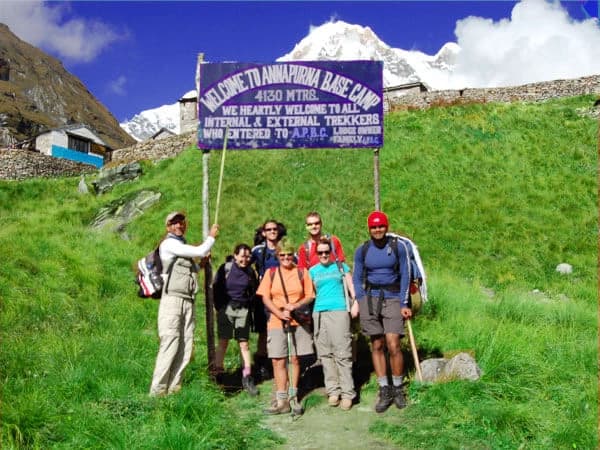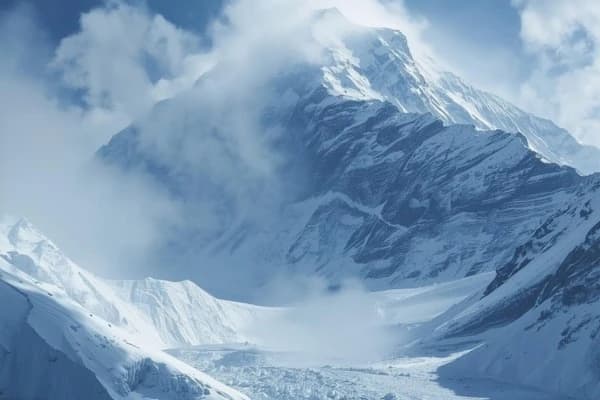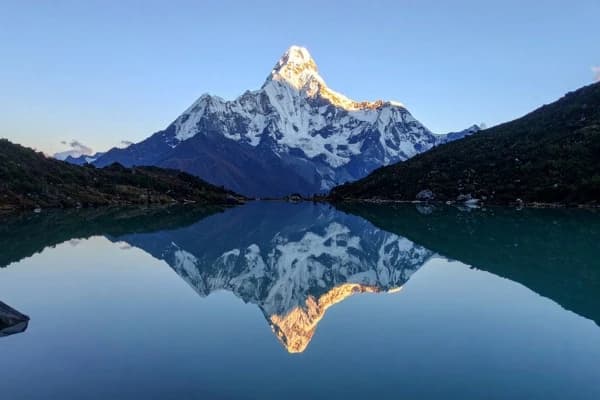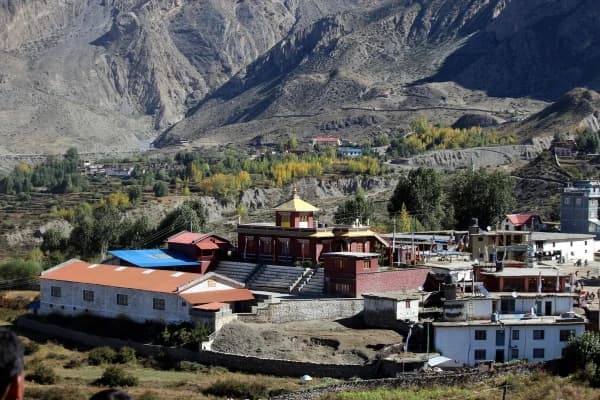Visualize yourself standing at the foot of the mighty Annapurna range, breathing in the fresh mountain air, surrounded by a riot of colorful rhododendron blooms. That’s exactly what trekking to Annapurna Base Camp Trek in May offers — a true Himalayan dream adventure.
Yet, many trekkers miss this magical experience simply because they aren’t sure when to plan their journey. Trekking in the wrong season can lead to unpredictable weather, tougher trails, and fewer chances to fully enjoy the stunning views.
If you're curious about why Annapurna Base Camp Trek in May is one of the best choices you can make, stick around. In this blog, we’ll dive into the weather, trail conditions, packing tips, and all you need to know to make the most of your Himalayan trek.

Why Choose May for the Annapurna Base Camp Trek?
Trekking to Annapurna Base Camp Trek in May is like catching the Himalayas at their best. May falls toward the end of Nepal's spring season, meaning the landscapes are lush, the skies are often clear, and the temperature is just right for hiking.
Another bonus of trekking in May? The trails are bursting with blooming rhododendrons and other alpine flowers, turning the forests into a vivid painting. It's warm enough that you won’t be freezing, but cool enough that you won't be sweating buckets either.
Because May is just before the monsoon season, you’ll also avoid the heavy crowds of peak months like October. It's the ideal combination of comfort to adventure.
In May, how does the weather at Annapurna Base Camp feel?
The weather at Annapurna Base Camp Trek in May is generally mild and pleasant, making it one of the best times for a trek. Here’s a quick breakdown:
- Daytime temperatures at lower elevations (such as Nayapul and Ghandruk) range from 15°C to 25°C (59°F to 77°F).
- At higher elevations (around Annapurna Base Camp), daytime temperatures should be between 5°C and 10°C (41°F and 50°F).
- At nighttime at the base camp, temperatures can drop close to freezing, so a good sleeping bag is essential.
Early May tends to be drier with clearer skies, while late May might bring occasional afternoon showers due to the approaching monsoon. But these showers are usually short and refreshing rather than heavy downpours.
Tip: Mornings are typically clearer, so starting your hike early helps you enjoy the best mountain views!
Highlights of Annapurna Base Camp Trek in May
Here’s what makes this time of year truly unforgettable:
- Rhododendron Remnants: Though their prime is in April, many mid-altitude forests still glow with late-blooming flowers.
- Photographer’s Paradise: Early May skies are crystal clear—ideal for snapping perfect mountain panoramas.
- Quiet Trails: Fewer crowds than peak season. It’s your time to soak in the silence and hear your own footsteps.
- Spring Energy: The air buzzes with vitality—birds chirping, bees humming, and forests rustling with new life.
- Emerging Greenery: Terraced fields slowly transform into vibrant green quilts as crops begin sprouting.
This mix of spring’s tail-end charm and early summer vitality makes Annapurna Base Camp Trek in May a journey for the senses.
Can You Explore Exotic Wildlife During the Trek?
May is a transition month—not too hot, not yet wet—perfect for wildlife activity. The Annapurna Conservation Area bursts with color and sound.
You might spot:
- Himalayan Monals flaunting their iridescent feathers
- Langurs leaping through the canopy
- A deer darting through the undergrowth
- Butterflies dancing between blooms
And if you’re a birdwatcher, you’re in for a treat. Migratory species fill the skies and forests with their songs before the rains drive them to shelter.
It’s like walking through a living, breathing nature documentary.
Are there any cultural events or Festivals in May?
May brings subtle, soulful celebrations. May brings subtle, soulful celebrations. Buddha Jayanti, which marks the anniversary of Lord Buddha's birth, enlightenment is among the most honored.
On this day, monasteries and temples along the route are adorned with butter lamps and prayer flags. Villagers can give trekkers sweets or hold little rituals If you visit places like Ghandruk or Landruk. It serves as a gentle reminder of the mountains' profound spiritual significance.
May also kicks off the energy of the agricultural season. Locals begin preparing their fields for rice planting. Though the actual planting happens later, the villages pulse with preparation and life.
How Tough Is the Annapurna Base Camp Trek in May?

Let’s be real — the Annapurna Base Camp trek isn't just a walk in the park. But for many trekkers, May offers some of the easiest conditions you'll find throughout the year.
The trails in May are mostly dry and clear, without the icy patches or deep snow that trekkers face in winter months. You’ll still need to manage a fair bit of ascending and descending, though — especially all those famous stone staircases.
The highest point, Annapurna Base Camp, sits at 4,130 meters (13,550 feet), so altitude is a factor. Some might experience mild symptoms like headaches or slight dizziness. Listening to your body, staying hydrated, and maintaining a steady pace are key.
If you're reasonably fit and take it slow, the Annapurna Base Camp trek in May is absolutely within reach, even for first-timers.
What Should You Bring for the May Annapurna Base Camp Trek?
The essentials you pack can have a huge impact on your trekking experience. Since the weather can shift quickly in the mountains, the key is layering.

Clothing Essentials
- Lightweight moisture-wicking base layers
- A couple of warm mid-layers (fleece or wool)
- Waterproof and windproof outer shell jacket
- Lightweight trekking pants (zip-off preferred)
- Wool hat and gloves (for cooler evenings)
- Comfortable hiking socks (at least 4–5 pairs)
- Down jacket (especially useful at higher elevations)
Footwear
- Well-broken-in hiking boots with ankle support
- Light sandals or camp shoes for evenings
Other Essentials
- Sleeping bag rated to -5°C (23°F)
- Day backpack (25–30 liters)
- Trekking poles (your knees will thank you)
- Sunscreen, lip balm, and sunglasses
- Water purification tablets
- Quick-dry towel and personal toiletries
- First aid kit, including blister care
- Lightweight rain jacket or poncho (for afternoon showers)
Having the right gear helps you stay comfortable no matter what weather surprises May throws at you. For more, click here.
Tips for a Successful Annapurna Base Camp Trek in May
Trekking to Annapurna Base Camp in May can be an unforgettable experience—lush landscapes, blooming rhododendrons, and warm (but not too hot) weather. But a few smart strategies can take your journey from good to truly great. Here’s what seasoned trekkers know that beginners will be glad to learn:
Start Your Days Early
In the Himalayas, mornings are your best friend. During May, the skies are clearest in the early hours, offering sweeping views of Annapurna South, Machapuchare (Fishtail), and Hiunchuli before clouds roll in. Rain tends to show up later in the afternoon, especially toward the end of the month.
Starting your trek by 6:30–7:00 AM means you’ll be off the trail by mid-afternoon, dry, and possibly enjoying a warm tea with a view while others are still getting soaked.
Take it Slow

Yes, you're excited—and you should be. But don’t let adrenaline push you into a pace your body isn’t ready for. Altitude sickness can hit even the fittest trekkers if they ascend too quickly.
Taking a steady, relaxed pace helps your body adjust to the elevation gradually, reduces fatigue, and lets you actually enjoy the scenery instead of rushing past it. Think of it as hiking in tune with the mountains, not against them.
Hydrate, Hydrate, Hydrate
At higher elevations, your body loses water faster, even if you’re not sweating heavily. And the kicker? You might not feel thirsty. Drink consistently throughout the day—at least 3 to 4 liters is a good target.
Carry a refillable bottle or a hydration bladder, and consider adding electrolyte powders to replenish what you lose through exertion. Teahouses along the trail can boil water for you, or you can use purification tablets or filters.
Protect Yourself from the Sun
The sun in the mountains is intense, and UV rays are stronger the higher you go. Even if it's a bit cloudy, you can end up with a nasty sunburn. Pack a high-SPF sunscreen (and actually use it), wear a wide-brimmed hat or cap, and don’t forget good sunglasses—snow or bright clouds can reflect a surprising amount of light back at your eyes.
Be Weather-Ready
May sits at the tail end of spring and just before the monsoon starts creeping in. That means mostly dry days, but with the occasional surprise afternoon shower. A lightweight waterproof jacket and a pack cover are essentials. Even if it doesn’t rain, clouds and wind can drop the temperature quickly, especially as you approach base camp.
Layering is your friend: think moisture-wicking base layers, a warm fleece, and a shell that blocks wind and rain.
Recommendation Read: Annapurna Base Camp Trek or Everest Base Camp Trek
Final Thoughts: Why May Is a Hidden Gem for Annapurna Base Camp
Annapurna Base Camp Trek in May isn’t loud or flashy—it’s poetic. It’s that quiet window where the wildflowers haven’t yet wilted, the rivers run strong with snowmelt, and the sky holds its breath before the rains come.
You’ll find beauty in every step—sunlit forests, sleepy mountain villages, and those breathtaking views of the Himalayas that make the trek worthwhile.
If May sounds like your perfect time to trek, don’t just dream it—live it. Let Nepal Gateway Trekking take care of the details so that you can focus on the experience. Contact us today to plan your unforgettable Annapurna Base Camp journey this May!
Featured Trips: Annapurna Base Camp Trek, Annapurna Panorama View Trek, Short Annapurna Circuit Trek, Short Annapurna Base Camp Trek
FAQs
Is May a good time for beginners to trek to Annapurna Base Camp?
Yes, May is a fantastic time for beginners—as long as you're reasonably fit and do some prep. The weather is mostly stable, the trails are in great condition, and temperatures are comfortable, especially compared to the chillier months.
You'll also get to experience vibrant forests and flowering rhododendrons, which add a splash of color to every step. As with any trek, preparation is key: give yourself time to acclimate, train a bit before the trip, and don’t skimp on gear.
How busy are the trails in May?
You’ll see other trekkers, but it’s far from overwhelming. May is considered shoulder season—popular, but not packed like October or November. That means you get the best of both worlds: lively teahouses and fellow travelers to swap stories with, without the crush of high-season crowds.
It’s a nice balance if you want some social atmosphere without needing to race for a room at each stop.
What challenges should I expect in May?
The main challenges in May are occasional rain showers, especially as the month progresses, and the usual issue of altitude adjustment. Neither should be a deal-breaker. Rain is usually brief and predictable if you plan your walking hours well.
As for altitude, the highest point of the trek is just over 4,100 meters—not extreme, but still high enough to require respect. Go slow, hydrate, and rest when you need to.
Are accommodations available during May?
Yes, teahouses along the Annapurna Base Camp route operate normally in May. You’ll find a mix of cozy, family-run lodges with basic but welcoming rooms, hearty meals, and even the occasional hot shower. Since it’s not peak season, availability is usually good—you might even get your pick of rooms in quieter villages.
Still, it’s wise to let your guide or lodge owner call ahead during busier weekends just in case.
What is the most scenic part of the trek in May?
That’s a tough one—this trail is packed with beauty. But if we had to pick, the stretch through rhododendron forests in full bloom between Chhomrong and Deurali is simply magical in May. The trail is alive with red, pink, and white blossoms under a green canopy.
And of course, the final approach to Machapuchare Base Camp (MBC) and Annapurna Base Camp (ABC) is breathtaking—snow-draped peaks encircle you in every direction. Standing at base camp, surrounded by giants like Annapurna I and Hiunchuli, is a moment you’ll never forget.
